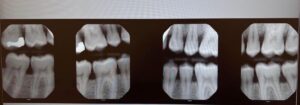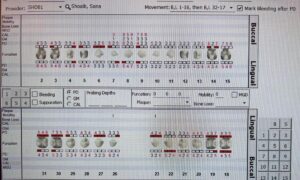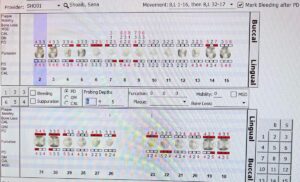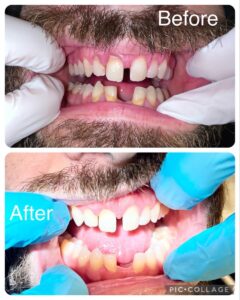CASE # 1 – ARESTIN PATIENT.
Patient info: “E.B. – 37 years old white male.” ASA: 2
MEDICAL HISTORY: 1) Vyvanse 30mg once daily for ADHD
2) Albuterol for asthma.
– No premedication. Minor seasonal allergies. He was a smoker but switched to vaping almost a year ago, and now vapes daily.
INITIAL VISIT:
The patient came to the clinic for the first time in Den 1200 on 02/23/22, however, he was dismissed as the patient has several teeth with probing depths of 7mm & it was indicated that an FMS or VBWs was necessary to start the treatment. He had a BP of 120/84mmHg on the initial visit. Last visit to the dentist was in 10/2019 for wisdom tooth extraction and he was exposed for x-rays at that time.
He was again called in for a limited visit in the last part of the semester to expose VBWs on 05/04/22 & was allowed to be treated at our clinic. The treatment was started in Den 2300 on 09/22/22 and he was exposed for FMS on the same day.
Extra-oral Findings: The patient had a slight asymptomatic TMJ crepitus.
Intra-oral Findings: He presented with bilateral linea alba. #24 & #25 were congenitally missing. Diastema between #7 & #8 and #8 & #9.
Oral hygiene routine: He used a medium bristle toothbrush in scrubbing motion twice a day. He used flossed 5 times a week but no rinse was used.
Periodontal Findings: Gingiva was bright red in color with no stippling. It was shiny and spongy in consistency with bulbous papilla. Anterior teeth had blunted papilla with type I embrasure. Gingival margin is apical to CEJ.
Radiographically, he presented 15-30 % horizontal bone loss on the VBWs. With localized vertical bone loss between #3 and #4, #7 and #8, #14 and #15. Generalized subgingival calculus evident.
On perio examination, he had probing depths ranging from 3mm – 7mm, with an 8mm present #8-MF. The recession was also present on #8-F & #9-F. Mobility class I in # 23 & # 26.
He was thus classified as a stage III B, based on the probing depths, CAL, tooth mobility & vertical bone loss. After all assessment’s completion, Dr. Brown recommended the patient as a suitable candidate for arestin treatment. Thus, he was educated about arestin treatment and its benefits.
Case value was heavy and caries risk was also high due to multiple suspicious lesions present radiographically.
1st visit summary (09/22/22): After disclosing, he was explained why an appropriate method of toothbrushing is necessary for him. Thus, Modified bass method of toothbrushing was demonstrated on the patient`s mouth. He was exposed for an FMS. Quadrant # 4 was scaled.
2nd visit summary (10/03/22): On this visit, the patient was very motivated because quadrant # 4 showed significant improvement. Inflammation was reduced clinically, and the patient also observed that bleeding has reduced while brushing. He also shared that he is following the toothbrushing method taught very strictly. He was more involved in the treatment planning now and acquired about rinses. I recommended him to use Listerine (anti-septic). Toothbrushing was revised with him, and C-Shape method of flossing was taught. During demonstration of flossing, it was observed that he had not used string floss before. He was explained that contact areas can only be kept cleaned by using an interdental aid. Moreover, proxy brush was recommended for diastemas and missing tooth spaces. Quadrants #1 & #2 were scaled on this day.
3rd visit summary (10/31/22): The patient was taking care of his oral hygiene and it was evident clinically also. He was using rinse now and flossing regularly. On this visit, he was re-probed on previously scaled 4 sites for arestin placement. All these sites showed improvement after scaling and presented with a 5mm probing depth. Quadrant # 3 was scaled and arestin was placed on #8-ML, #15-MF, #30-DL, and #31-ML. He was handed over the information sheet for arestin & given post-op instructions. He was scheduled to visit after 4 weeks for arestin site evaluation.
4th visit Arestin Re-evaluation (12/05/22): He reported that there is no bleeding during brushing and flossing now. Arestin reduced probing depths significantly.
| SITE | INITIAL PROBING | DAY OF PLACEMENT | DAY OF EVALUATION |
| #8-ML | 7 mm | 5 mm | 4 mm |
| #15-MF | 7 mm | 5 mm | 3 mm |
| #30-DL | 7 mm | 5 mm | 3 mm |
| #31-ML | 6 mm | 5 mm | 5 mm |
The patient was explained the changes in the probing depths. He was very content and satisfied with the whole treatment process. He showed interest and was motivated now to take care of his oral cavity. On day one when I saw him, it was clearly evident that the patient was not taking care of his oral cavity but he was very involved in the treatment by the time we finished it. He did not miss any appointments and was very cooperative. As a clinician, when I review this case, it makes me feel more confident in my skills. Moreover, it gives me a better understanding that no treatment is complete without patient`s input.







